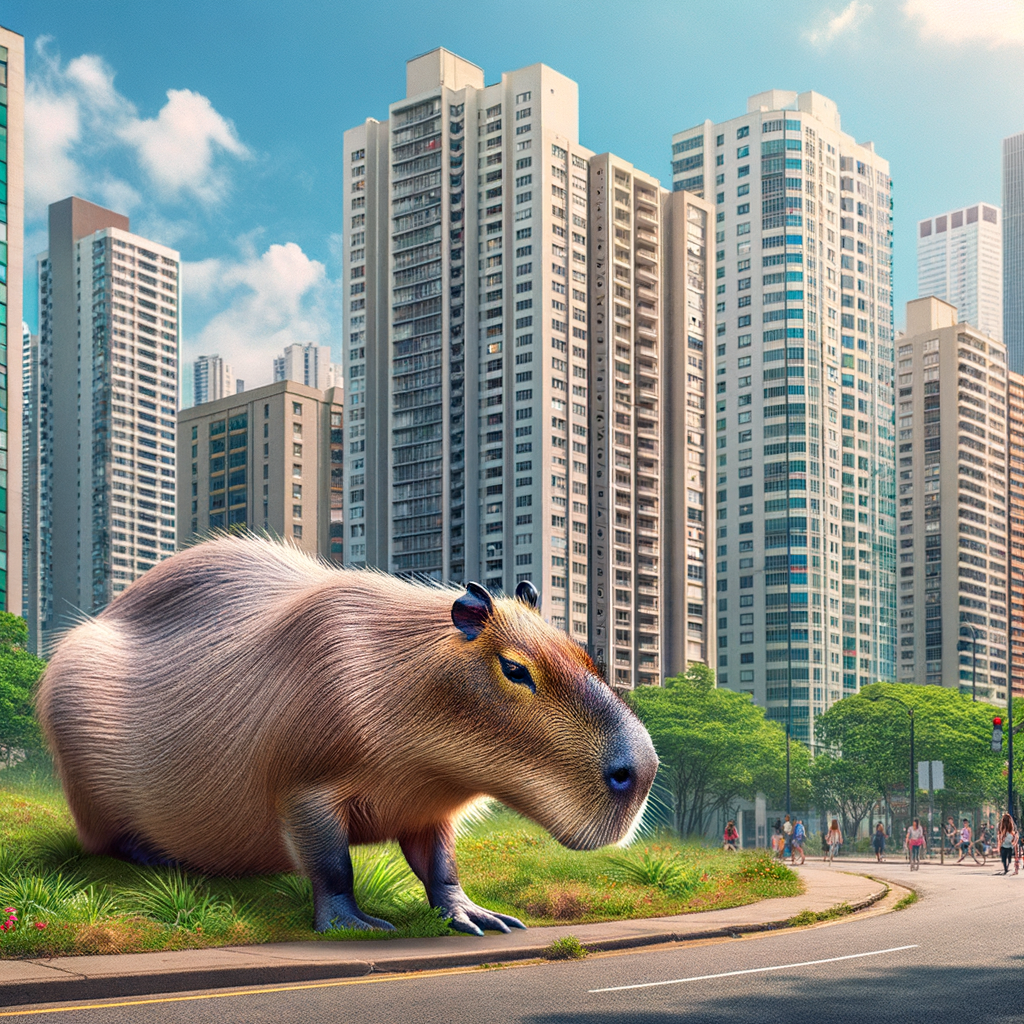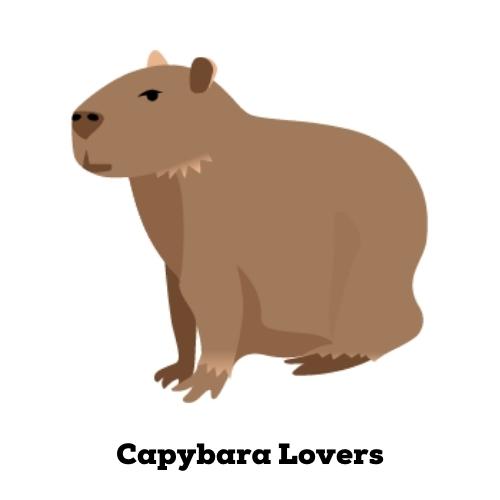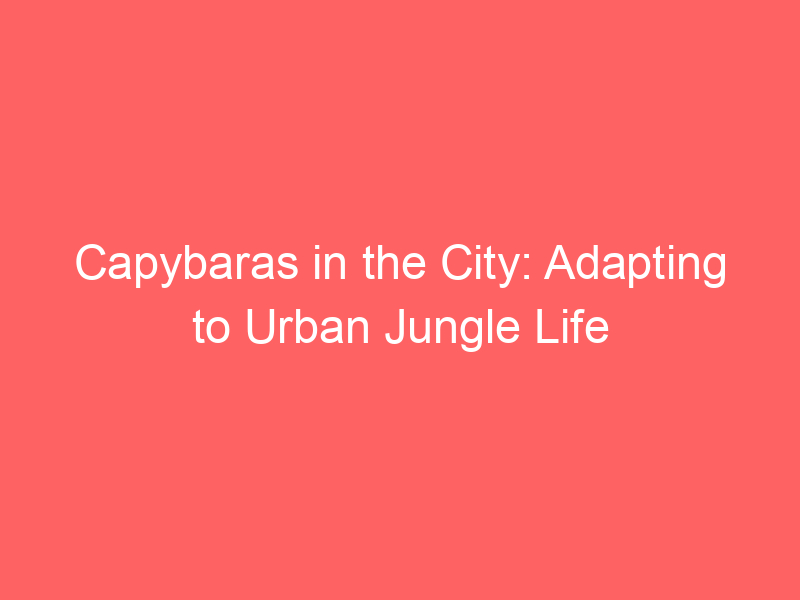
Introduction to Urban Capybaras
When we think of wildlife, we often imagine vast forests, open plains, or deep oceans. However, the reality is that many animals are adapting to life in urban environments. One such creature is the capybara, the world’s largest rodent, which is increasingly being spotted in cities. This article will provide an overview of urban capybaras and discuss the broader trend of wildlife urbanization.
-
- Overview of Capybara in the City
Originally native to South America, capybaras are semi-aquatic mammals that can weigh up to 150 pounds. They are highly social animals, often found in groups. In recent years, these creatures have been spotted more frequently in urban areas, particularly in cities near their natural habitats. Capybaras are known for their adaptability, which allows them to thrive in a variety of environments. In the city, they can be seen grazing on grass in parks, lounging by bodies of water, and even navigating busy streets. Their presence in urban areas is a testament to their resilience and adaptability.
-
- Urbanization of Wildlife
The phenomenon of wildlife urbanization is not limited to capybaras. As cities expand into natural habitats, many species are learning to coexist with humans in urban environments. This trend is driven by a combination of factors, including habitat loss, availability of food, and changes in climate. While some species struggle to adapt, others, like the capybara, have shown remarkable resilience. Understanding this trend is crucial for both wildlife conservation efforts and urban planning.
As we delve deeper into the world of urban capybaras, we will explore how these animals adapt to city life, the challenges they face, and what their presence means for the future of urban wildlife. Stay tuned to learn more about these fascinating creatures and the broader implications of wildlife urbanization.
Capybara Adaptation to City Life
As the world’s largest rodents, capybaras have shown a remarkable ability to adapt to urban environments. This section will explore some of the physical adaptations that have enabled them to thrive in city life.
Physical Adaptations
Physical adaptations are changes in an animal’s body structure that help it survive in its environment. For capybaras, these changes are primarily related to their size, weight, and diet.
-
- Size and Weight
Capybaras are typically around 1.2 meters (4 feet) long and can weigh up to 66 kilograms (145 pounds). This large size helps them navigate through city obstacles like fences and walls. In urban areas, capybaras have been observed to maintain a healthy weight, which is crucial for their survival.
-
- Dietary Changes
Capybaras are herbivores, primarily feeding on grasses and aquatic plants. However, in cities, they have adapted to a more varied diet. They have been observed eating fruits, vegetables, and even some types of city plants. This dietary flexibility allows them to make use of available food sources in urban areas.
In conclusion, the capybara’s large size and dietary adaptability have played significant roles in their successful adaptation to city life. These physical changes have allowed them to navigate urban environments and find sufficient food sources, contributing to their survival and growth in cities around the world.
Behavioral Adaptations
As capybaras adapt to city life, they exhibit unique behaviors that help them survive in urban environments. These behaviors are not only fascinating to observe but also provide insights into how animals can adapt to human-dominated landscapes.
-
- Capybara behavior in urban environments
Capybaras are known for their calm and social nature. In urban environments, these traits are even more pronounced. Unlike their counterparts in the wild, urban capybaras have learned to navigate city landscapes with ease. They often use man-made structures for shelter and have adapted their feeding habits to include urban food sources. For example, they have been observed eating grass from public parks and even leftover food from garbage bins.
Another interesting behavior of urban capybaras is their ability to cross roads safely. They have learned to wait for the traffic to clear before crossing, demonstrating their ability to adapt to city life. This behavior is a testament to their intelligence and adaptability.
-
- Interactions with humans and other city animals
Urban capybaras have also shown remarkable adaptability in their interactions with humans and other city animals. They are generally tolerant of humans and can often be seen in close proximity to people in parks and other public spaces. This is likely due to their understanding that humans pose little threat in these environments.
As for their interactions with other city animals, capybaras have been observed living in harmony with a variety of species. They share their habitats with birds, squirrels, and even domestic pets. This ability to coexist with other species is another key factor in their successful adaptation to urban environments.
In conclusion, the behavioral adaptations of urban capybaras provide a fascinating glimpse into how wildlife can adapt to city life. These adaptations not only ensure their survival but also enrich our urban ecosystems with their presence.
Challenges Faced by Urban Capybaras
Living in the city is not a walk in the park for capybaras. They face numerous challenges that threaten their survival. Let’s delve into some of these challenges.
- Threats from Traffic and Human Activities
One of the significant challenges faced by urban capybaras is the threat from traffic and human activities. As cities expand, capybaras often find themselves living close to roads and highways. This proximity to traffic puts them at risk of being hit by vehicles, leading to injuries and fatalities. According to a study, a significant number of capybaras in urban areas are victims of road accidents.
Human activities also pose a threat to these creatures. Noise pollution from construction sites, factories, and vehicles can cause stress and disrupt their natural behavior. Additionally, capybaras may ingest harmful substances like plastic when they come into contact with human waste, leading to health complications.
- Loss of Natural Habitat
Another challenge faced by urban capybaras is the loss of their natural habitat. As cities grow, forests and wetlands are often cleared to make way for buildings and roads. This leads to a loss of the natural habitats where capybaras live and find food.
Without their natural habitat, capybaras are forced to adapt to city life, which can be stressful and challenging. They may struggle to find food and shelter, and their survival rates may decrease. Moreover, the loss of natural habitats can lead to a decrease in the capybara population, as they have fewer places to breed and raise their young.
In conclusion, urban capybaras face significant challenges due to traffic, human activities, and the loss of their natural habitat. It’s crucial to address these issues to ensure the survival of these fascinating creatures in our cities.
Case Studies: Capybara Lifestyle in Different Cities
Let’s take a closer look at how capybaras live in different cities. We’ll start with Rio de Janeiro, a city known for its vibrant culture and biodiversity.
Capybaras in Rio de Janeiro
In Rio de Janeiro, capybaras have become a common sight. They are often spotted in parks, golf courses, and even on the city streets. Let’s delve into the details of their population size, distribution, key challenges, and solutions.
-
- Population size and distribution
According to recent studies, the capybara population in Rio de Janeiro is estimated to be around 5,000. These semi-aquatic mammals are mostly found in the city’s green spaces, such as the Tijuca National Park and the Rio de Janeiro Botanical Garden.
-
- Key challenges and solutions
The primary challenge for capybaras in Rio de Janeiro is the loss of natural habitat due to urbanization. This has forced them to adapt to city life, often leading to conflicts with humans. However, local authorities and wildlife organizations have been working together to create safe spaces for these animals. They have also launched awareness campaigns to educate the public about coexisting with capybaras.
In conclusion, capybaras in Rio de Janeiro have shown remarkable adaptability despite the challenges posed by urbanization. Their presence in the city serves as a reminder of the importance of preserving natural habitats and promoting coexistence between humans and wildlife.
Capybaras in Buenos Aires
Let’s shift our focus to Buenos Aires, the capital city of Argentina. Here, capybaras have become a common sight, cohabiting with humans and other city animals. Their adaptation to city life is a fascinating study in itself.
-
- Interaction with Humans and Other City Animals
In Buenos Aires, capybaras have learned to coexist with humans and other city animals. They are often seen in parks and green spaces, where they graze on grass and enjoy the water bodies. Despite their size, capybaras are generally peaceful creatures, and they have been able to establish a harmonious relationship with humans and other animals in the city.
Interestingly, capybaras have been observed to interact with other city animals, such as dogs and cats. They are not aggressive, and they often share their space with these animals. This peaceful coexistence is a testament to the capybara’s adaptable nature.
-
- City Adaptation in Animals: Capybara as an Example
The capybara’s adaptation to city life in Buenos Aires is a remarkable example of how animals can adjust to urban environments. Capybaras are originally from the wetlands of South America, but they have been able to thrive in the urban setting of Buenos Aires. They find food in the city’s parks and green spaces, and they have learned to navigate the city’s streets and traffic.
One of the key factors in the capybara’s successful city adaptation is their diet. Capybaras are herbivores, and they can eat a wide variety of plants. This dietary flexibility allows them to find food in the city. Additionally, capybaras are excellent swimmers, and they have been able to use the city’s water bodies to their advantage.
In conclusion, the capybaras of Buenos Aires are a wonderful example of how animals can adapt to urban environments. Their peaceful coexistence with humans and other city animals, as well as their ability to find food and navigate the city, are testament to their adaptability. As we continue to study urban wildlife, the capybara serves as a valuable case study.
Implications of Urban Wildlife: The Capybara Example
When we think about wildlife, we often picture animals living in forests, jungles, and other natural habitats. However, many animals, like the capybara, have adapted to live in urban areas. This shift has significant implications for city ecosystems and urban planning. Let’s explore these effects using the capybara as an example.
- Effects on City Ecosystems
Capybaras, the world’s largest rodents, have become a common sight in many cities. They are herbivores, meaning they eat plants. Their presence can affect the city’s ecosystem in several ways. For instance, they can help control the growth of certain plants by eating them. However, if their population grows too large, they might overgraze, leading to a decrease in plant diversity.
Moreover, capybaras can also influence the populations of other animals in the city. They can serve as a food source for predators, like coyotes or large birds. This can lead to an increase in the predator population. On the other hand, they might compete with other herbivores for food, potentially leading to a decrease in the population of these species.
- Implications for Urban Planning and Wildlife Management
The presence of capybaras in cities also has implications for urban planning and wildlife management. City planners and wildlife managers need to consider how to coexist with these animals. For example, they might need to design parks and green spaces in a way that can accommodate capybaras and other wildlife. This might include providing areas with water and plants that capybaras like to eat.
Wildlife managers might also need to monitor the capybara population to ensure it doesn’t grow too large and negatively impact the ecosystem. This could involve implementing measures to control their population, such as sterilization programs or relocation efforts.
Furthermore, city officials might need to educate the public about how to interact with capybaras. This could include teaching people not to feed them, as this can disrupt their natural diet and behavior.
In conclusion, the presence of capybaras and other wildlife in cities can have significant effects on city ecosystems and urban planning. It’s important for us to understand these implications so we can learn how to live in harmony with our urban wildlife neighbors.
Conclusion: The Future of Urban Capybaras
As we reach the end of our exploration into the world of urban capybaras, it’s time to look towards the future. What does it hold for these adorable creatures? Let’s delve into some predictions and key takeaways about urban wildlife.
-
- Predictions for Capybara adaptation in the future
Given the capybara’s remarkable adaptability, we can expect to see more of these creatures in urban settings. Their ability to thrive in various environments, coupled with their sociable nature, makes them well-suited to city life. However, this doesn’t mean it will be an easy journey.
As cities continue to expand, capybaras will face new challenges. They will need to navigate increasingly busy roads, avoid potential threats, and find suitable food and water sources. But with the right support and conservation efforts, there’s every reason to believe that capybaras can continue to thrive in urban environments.
-
- Key takeaways about urban wildlife
Our exploration of urban capybaras has provided some important insights into urban wildlife. Firstly, it’s clear that wildlife can and does adapt to city life. However, this adaptation isn’t without challenges. Urban environments pose unique threats to wildlife, from traffic to pollution to habitat loss.
Secondly, the presence of wildlife in cities can enrich our lives, providing opportunities for education and inspiration. But it’s a two-way street. We must respect and protect these creatures, ensuring they have the resources they need to thrive.
In conclusion, the future of urban capybaras is a fascinating topic. It’s a testament to the resilience of wildlife and a reminder of our responsibility to protect it. As we move forward, let’s keep these lessons in mind, fostering a harmonious coexistence between humans and urban wildlife.













